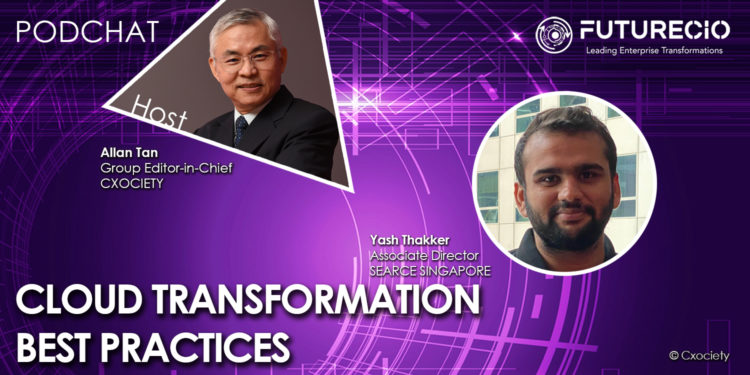There is a growing perception that digital transformation is about moving a business’ critical applications to the cloud. By migrating applications to the cloud a business will be agile, see significant improvement in how a company operates, and become a digital-native company.
By most accounts, migration to the cloud is no longer a question of if ever the business will do it, but a matter of how soon it can be done, how safely it can be done, and how to transition to either a full-on cloud or hybrid IT operations.
Yash Thakker, associate director at Searce Singapore, says that for organisations looking at digital transformation, the cloud is a choice by default. He opines those enterprises want to be agile, they want to have a grip on top of the digital native counterparts, which are beating them in the business.
“They need to adapt to an environment that is scalable and flexible to push out products and solutions at a faster pace. One of the key components is migrating and modernising applications on the cloud,” he continued.
Key components of a cloud migration
Everyone has an opinion as to the composition of a cloud migration exercise. Naturally, it should include the answers to why a business wants to do it – and it shouldn’t be ‘because everyone else is doing it.’
Thakker says it is important to understand an organisation’s motivation for pursuing a migration. He lists four potential motivating factors:
- Cost optimisation: Optimising their costs moving from capital expense (CapEx) to operating expense (OpEx).
- Power and scaling: Move of company’s application to auto-scaling, their databases are more robust, and they don't need to procure, very large machines, even for peak duration
- API: These businesses look at leveraging the power of the cloud in form of their API strategy, monolith to microservices breakdown of their application driving new revenue streams, etc.
- Unique businesses: These businesses build their SRE practice on top of the cloud platforms and ensure that they are secure, reliable, and scalable
Cloud migration vs cloud-led transformation
For the record, cloud migration is the process of changing an organisation’s underlying IT infrastructure from one platform to another. In this case, moving from an on-premises (or co-located) infrastructure to cloud-based operations.
The confusion occurs, sometimes, because, in many digital transformation discussions, the cloud is often seen as one of the inevitable exercises that need to be undertaken as part of the process. By migrating to the cloud, organisations can leverage the technology to help drive innovation, including digital transformation.
Hence, people may misinterpret cloud migration as already undertaking cloud transformation.
Thakker points out that cloud migration is moving expenses from CapEx to OpEx. He argues cloud migration does not help an organisation in terms of its agility aspirations or ability to scale.

On the other hand, for companies that are on an IT infrastructure and application modernization track. “This is where there is a major focus on understanding the overall from a business perspective and looking at existing landscape to come up with an overall transformation roadmap,” he continued.
“This is where the actual value of cloud comes in, where you evaluate your infrastructure landscape, see what future state of this application and the business function looks like, then define a strategy on the cloud which helps you achieve those goals you have set.”
Yash Thakker
What cloud migration does not deliver
Thakker warns that performing a cloud migration (lift-and-shift) only “brings your technology debt on a platform where it's not tested. It is not that you will not get any benefit from cloud migration, it is that there is a high chance that your overall transformation plan will fail, because these applications might not be suited for the cloud platform.”
He acknowledges that businesses today are under heavy cost pressures, as they face up to changing regulations, and evolving competitive landscape, including the emergence of digital players. “You need to be on your heels in terms of defining and deploying your applications and infrastructure to meet the competitive demand,” he opined.
Just being on the cloud is no silver bullet.
Determining the right transformation approach
A cloud transformation strategy and journey for an organisation will depend on the goals that it has set for itself. The first step of a transformation needs to begin with goal setting.
Thakker lists a few steps towards determining an organisation’s cloud transformation journey:
- Set goals and define your business strategy
- The investment you are willing to contribute to this transformation journey
- What is your ambition after this transformation (more revenues, pivoting into a different business model or opening a new monetization channel)?
- What kind of cloud transformation does your business require?
“There are different tracks that we follow and all of them require significantly different investments and these questions are important as a lot of effort is required to reach these goals,” he concluded.
Click on the PodChat player and listen to Thakker share his perspective on cloud-led transformation, including prevailing misconceptions, wrong practices, and some recommendations on getting a business looking to transform itself in the cloud back on track.
- What is cloud-led transformation?
- What are the components of cloud transformation?
- Just to clarify: what is the difference between cloud transformation and cloud migration?
- How would cloud transformation benefit businesses that they won’t get from cloud migration?
- Are all cloud technologies/approaches the same?
- How does a business determine the right cloud transformation approach for them?
- Can you share 3 tips to avoid when sourcing third-party providers to help with the transformation?
- Can you share 3 tips for a successful cloud transformation strategy?
- What would be the make-up of the team inside the company that would lead this transformation?





